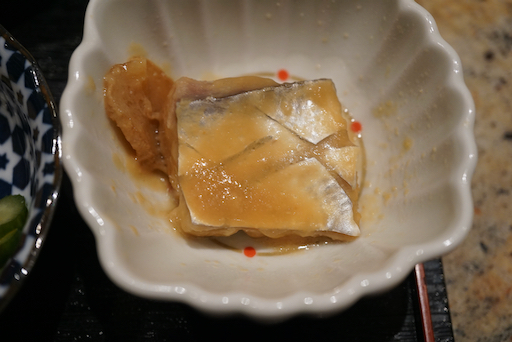Although this vegetable is called Japanese pumpkin, "Kabocha" カボチャ, it is a type of winter squash. This dish is the most common way to serve kabocha. Again, like many Japanese dishes most of the work for this dish is in the preparation of the squash. It appears that kabocha is grown in North America especially in California and Florida and, reportedly, many are exported to Japan. You can sometimes get kabocha even in regular grocery stores. The quality of the kabocha can vary a lot and success of this dish depends on the quality of the kabocha.
Cut the kabocha in half using a heavy chef's knife or cleaver and remove the seeds and "guts". I cut the halves into 8th or to a large bite size pieces. I "shave off" the skin just leaving a hint of green behind (meaning the remaining layer of skin is extremely thin). I do this by securely placing the piece of kabocha on the cutting board and using a heavy chef's knife or vegetable cleaver "nakiri" 菜切り包丁. I use a paring knife and bevel all the sharp edges 面取り and soft parts (near where the seeds were). This is to prevent the kabocha from crumbling while cooking. Do not discard these scraps. I always use them to make a wonderful kabocha pottage (see below).
In a saute pan large enough, put all the kabocha pieces in a single layer with skin side down. Add "dashi" broth so the kabocha pieces are half submerged. Sprinkle sugar over the kabocha pieces (for the amount of kabocha which will fit in a 12 inch saute pan, I use about 2-3 tbs of sugar but but you can use more), and 2 tbs each of soy sauce (if you do not want the kabocha to color too dark, you could use "usukuchi" or light colored soy sauce) and sake. Cover and simmer for 10 minutes until kabocha is cooked through. Remove the lid and turn up the flame, gently shake the pan and reduce the liquid until it just coats the bottom of the pan and glazes the kobocha. Let it cool down in the pan and serve at room temperature.
Kabocha Pottage カボチャのポタージュ
I make Kabocha pottage from the scraps when I make the above kabocha dish. The recipe is very standard for any type of pottages. I mince one medium onion and saute in melted butter in a deep pan until soft and semi-transparent, season with salt and pepper. Peel and cut up one small potato into small cubes. Add to the pan with the kabocha scraps, saute briefly and add chicken stock to cover (I used a commercial, 1/3 less salt, non-fat variety from Swanson which comes in a carton). Add two bay leaves and simmer for 15-20 minutes or until all the ingredients are soft. Take off the pan from the burner and make sure to remove the bay leaves. Using an immersion blender (or food processor), process until smooth consistency is achieved and no solids remain (you may add more chicken stock to adjust the consistency). Add 1/3 cup (or whatever amount you prefer) of cream, mix and put the pan back on the burner, adjust the seasoning. I often add a small amount of white miso as a "hidden taste" 隠し味 for some Japanese touch but it is optional. I often serve this with the leftover stewed kabocha as seen above. Here, I garnished it with minced parsley.

















































